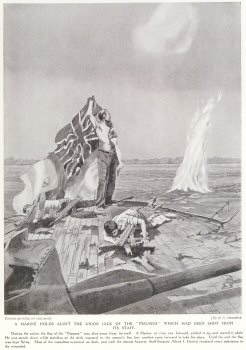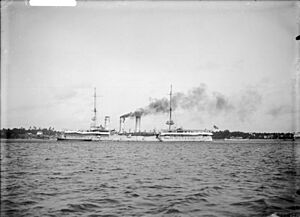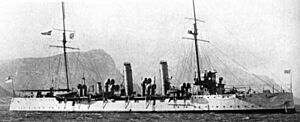Battle of Zanzibar facts for kids
Quick facts for kids Battle of Zanzibar |
|||||||
|---|---|---|---|---|---|---|---|
| Part of World War I | |||||||
 A Royal Marine, holding up the White Ensign aboard HMS Pegasus during the battle off Zanzibar. |
|||||||
|
|||||||
| Belligerents | |||||||
| Commanders and leaders | |||||||
| Strength | |||||||
| 1 light cruiser | 1 protected cruiser 1 tugboat |
||||||
| Casualties and losses | |||||||
| None | 39 killed 55 wounded 1 protected cruiser sunk 1 tugboat damaged |
||||||
The Battle of Zanzibar was a naval fight during the early days of World War I. It happened between the German Navy (called Kaiserliche Marine) and the British Royal Navy. The German ship, SMS Königsberg, was getting coal in German East Africa. Its crew found out that a British ship, HMS Pegasus, was in Zanzibar for repairs. The captain of Königsberg, Max Looff, decided to attack Pegasus while it was in port.
On September 20, 1914, Königsberg sailed into Zanzibar harbour. It passed a small British guard ship, HMS Helmuth. Helmuth could not warn Pegasus in time. This meant Königsberg attacked Pegasus by surprise. Pegasus was badly damaged before it could even shoot back.
Königsbergs guns could shoot much farther than Pegasuss guns. This meant Pegasus could not hit the German ship. The battle was very one-sided. Pegasus sank later that day. Thirty-eight of its crew members died. This battle was a clear German victory.
Contents
Why Did the Battle of Zanzibar Happen?
Shortly after World War I began, on September 19, 1914, Commander Max Looff was on his ship, the light cruiser SMS Königsberg. He was getting coal in the Rufiji Delta. He then heard from people watching the coast that a British warship had entered Zanzibar harbour.
Looff thought the ship in Zanzibar was either HMS Astraea or HMS Pegasus. He ordered an attack right away. Königsberg was ready for battle because it had just been resupplied. Königsberg left that afternoon to sail to Zanzibar.
What Ships Were Involved?
The British protected cruiser Pegasus was commanded by Captain John Ingles. It had just left two other British ships, HMS Astraea and Hyacinth. Pegasus was in Zanzibar to fix its boilers and engines.
The British also had a captured German tugboat in Zanzibar. It was called HMS Helmuth. They had put a small 3-pounder gun on it. Helmuth was placed as a guard ship at the entrance of the harbour.
How Were the Ships Armed?
Königsberg was built in 1905. It had ten 10.5 cm quick-firing guns. It also had ten smaller 5.2 cm guns for fighting torpedo boats. Plus, it had two 18-inch torpedo tubes.
Pegasus was an older ship, built in 1897. It was a protected cruiser. It had eight QF 4-inch guns and eight 3-pounder guns. It also had two 18-inch torpedo tubes. Pegasus had a crew of 234 officers and sailors.
How Did the Battle Unfold?
At dawn on September 20, Königsberg entered Zanzibar harbour from the south. It sailed past the guard ship Helmuth. Königsberg fired a few warning shots as it went by. Helmuth could not stop Königsberg from entering. It also could not warn Pegasus that the German ship was coming.
The Surprise Attack on Pegasus
When Königsberg got within about 9,000 yards of Pegasus, it started firing its guns. Pegasus was anchored in Zanzibar Harbour. It was getting ready to make steam, so it could not move. For about 20 minutes, Königsberg kept firing while Pegasus stayed still.
Pegasus did raise its White Ensign (the British flag) and began firing back. But its shells landed far short of Königsberg. The German cruiser slowly moved closer, firing until it was about 7,000 yards away. One of the first British sailors hurt was Lieutenant Richard Turner. He was the gunnery officer and was badly wounded by shrapnel.
The British kept fighting for about 20 more minutes. Pegasus took more hits from Königsberg. Most of the shells landed on Pegasus deck. Its flag was shot away during the fight. Because the Germans were always at least 2,000 yards beyond the range of Pegasus guns, no British shots hit Königsberg.
Pegasus was hit near its waterline and started taking on water. Captain Ingles knew there was no hope of winning. He lowered his flag (a sign of surrender) and told his crew to leave the ship. Pegasus sank later that day.
Königsberg's Final Shots
After Königsberg finished with Pegasus, it fired a few shots at Helmuth. The crew of Helmuth managed to leave their ship before one of Königsberg's shots hit the tugboat. After winning clearly, Königsberg turned around. It headed back to the Rufiji Delta.
What Happened After the Battle?
The British Navy lost Pegasus, which sank. Their tugboat Helmuth was damaged. Thirty-eight British sailors from Pegasus died. Another 55 sailors were wounded. Most of them were on the ship's deck when they were hit.
The ship's doctor, Alfred J. Hewitt, was on Pegasus' deck the whole time. He helped wounded sailors and marines. Captain Ingles later praised Hewitt for his brave actions. Even though Helmuth was hit, the damage was not too bad. Its crew got back on board after Königsberg left. Only one person on Helmuth died. He was a local worker in the engine room.
The hospital ship Gascon and the Scottish merchant ship Clan Macrae rescued the survivors from Pegasus. Twenty-four of the British sailors who died were buried in a mass grave. This was in the naval cemetery on Grave Island, Zanzibar. Fourteen others were buried in the town's cemetery. Later, in 1971, they were moved to the Dar es Salaam war cemetery. The British saved six of Pegasus' guns from the wreck. They later used these guns in the land fighting during the East African Campaign.
Even though Königsberg was not hit and had no one hurt, Captain Looff's plans to keep attacking were soon stopped. One of his ship's main engines broke down. The British were watching the port of Dar es Salaam. So, Königsberg had to go back to the Rufiji River delta. It had to wait for spare parts to be brought overland.
The British soon found out where Königsberg was hiding. They set up a blockade to trap it. They damaged Königsberg so badly that it could not be fixed. This happened in the Battle of Rufiji Delta in July. The British used special ships called monitors, HMS Mersey and Severn, to defeat Königsberg.
See also



